When Sony launched its VPL-HW40ES projector two years ago, no one – probably not even Sony themselves – could have anticipated the runaway success it eventually became. By removing the adjustable iris found on the step-up VPL-HW55ES, the Japanese brand brought the price of its SXRD projectors below the psychologically important £2,000 barrier for the very first time, and didn’t buyers lap it up.

Which brings us to its direct successor, the Sony VPL-HW45ES we’re reviewing today. The chassis remains unchanged, featuring a centrally-mounted lens and right-sided connections comprising two HDMI inputs as well as a USB port with newly-added firmware updating capability. We tested the pearlescent white version, but there’s also a glossy black edition for owners seeking a more discrete install in a dedicated home theatre room.
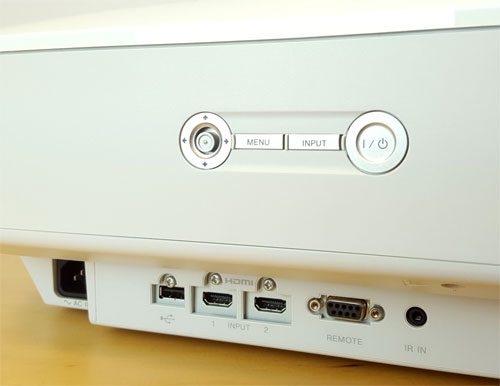
Improvements under the hood versus the HW40 are evolutionary rather than revolutionary. An uprated 215w lamp increased brightness slightly from 1700 to 1800 lumens, and operational life from 5000 to 6000 hours in low-lamp mode. The RF (radiofrequency) 3D emitter is now built-in too, although 3D glasses still have to be purchased separately.
Calibration was straightforward. The first thing we did was switch [Lamp Control] from the blindingly bright (by our bat cave standards) “High” mode to “Low“, which also suppressed fan noise to blissfully quiet levels. Even then, we still found the projected image a bit too bright, and wished there’s at least a manual iris on board that let us attenuate light output and deepen black-level response. Then again, perhaps implementing such a feature would push the HW45’s price north of £2k, so it’s a case of you win some, you lose some.
We calibrated our Sony VPLHW45ES review sample using a profiled Klein K10-A meter, a DVDO AVLab TPG signal generator, and SpectraCal’s CalMAN Ultimate software. While we could’ve obtained a tighter greyscale using Sony’s Projector Calibration Pro software (which allowed for 10p adjustments), the onboard two-point white balance and colour management system (CMS) controls were sufficient for us to achieve highly accurate colours – none of the 140 measured patches in the Colour Checker SG chart exceeded the humanly perceptible threshold of delta error (dE) 3.
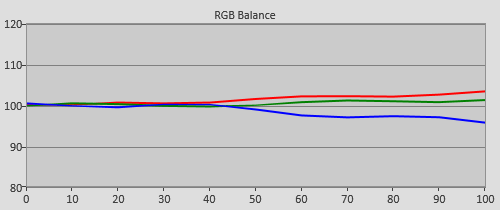 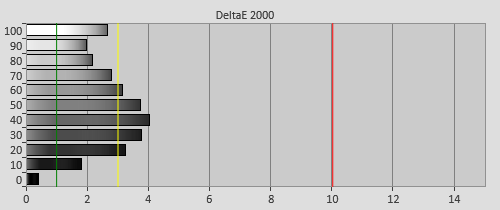 |
| Pre-calibration RGB tracking and delta errors (dEs) in [Reference] mode |
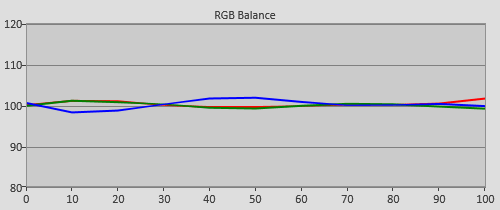 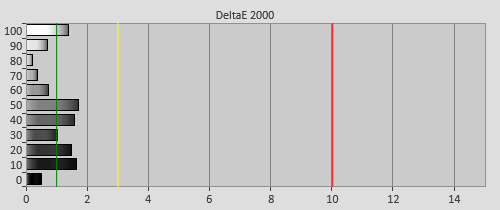 |
| Calibrated RGB tracking and dEs after 2p & 10p white balance adjustments |
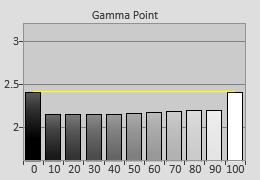 |
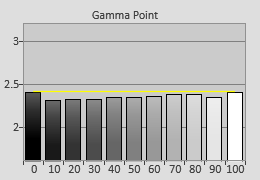 |
| Pre-calibration gamma tracking (2.17) | Post-calibration gamma tracking (2.35) |
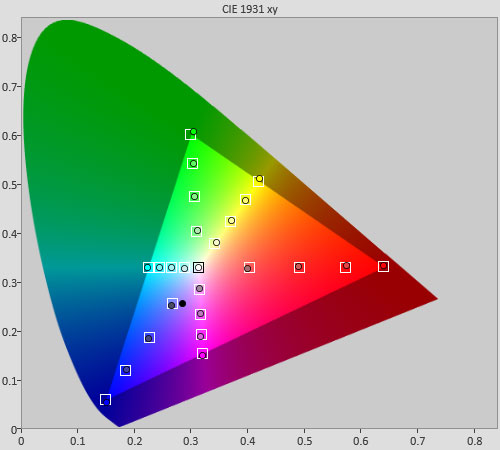 |
| Post-calibration colour saturation tracking in [Reference] mode |
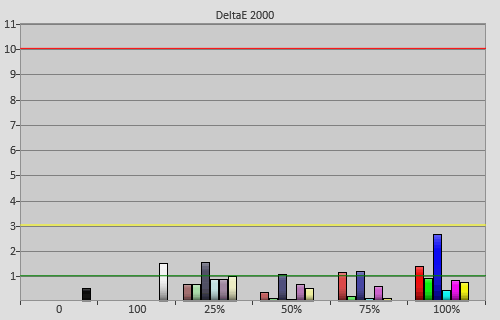 |
| Post-calibration colour errors (<3 not appreciable to the eye) |
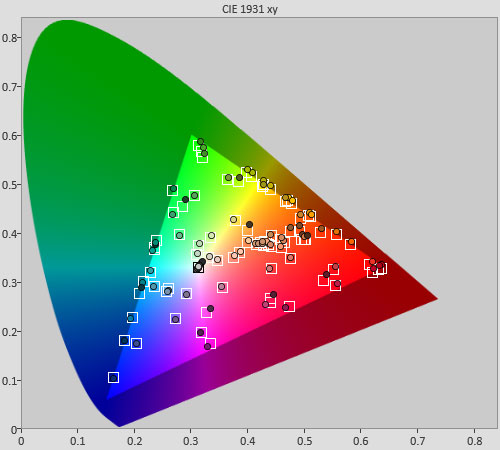 |
| Post-calibration Colour Checker SG test in [Reference] mode |
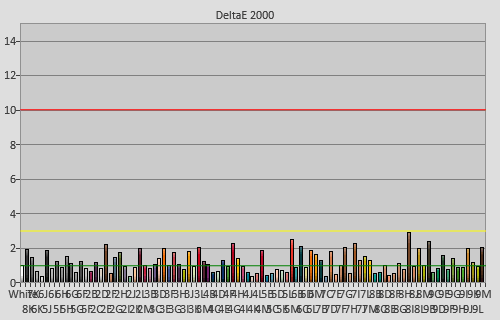 |
| Post-calibration Colour Checker SG errors (<3 not visible to the eye) |
Benchmark Test Results
| Dead pixels | None |
| Panel uniformity | Very good |
| Primary chromaticity | Excellent |
| Motion resolution | 700 to 900 with [Motionflow] enabled; 300 otherwise |
| Digital noise reduction | Forced temporal smoothing unless [Input Lag Reduction] on |
| Sharpness | Defeatable unless [Motionflow] “Combination” or “Inpulse“ |
| Luma/Chroma bandwidth (2D Blu-ray) | Full Luma & Chroma |
| 1080p/24 capability | No judder in 2D or 3D |
| Input lag (Leo Bodnar tester) | 22ms with [Input Lag Reduction] engaged |
Picture Quality
There’s no significant difference between the post-calibrated images delivered by the Sony VPL-HW45ES and the outgoing VPL-HW40ES. Black level appeared impressively deep, outperforming every other projector from rival brands within the sub-£2000 price class. To get even inkier blacks, you would have to upgrade to one of JVC’s D-ILA projectors costing at least twice the price.
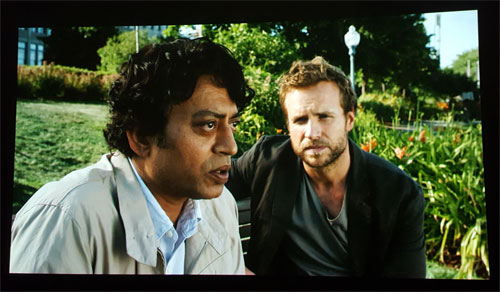
With formidable blacks come vibrant colours, and yet the HW45 – through its spot-on post-cal colour accuracy – was able to maintain believability without veering towards oversaturation. As with all Sony displays in recent years, the projector rendered slow panning shots in 1080p/24 content (e.g. from Blu-ray) beautifully without any judder or stutter.
Sony projectors – even the most high-end ones costing five figures – have always applied a light layer of background noise reduction (NR) even with [Noise Filtering] “Min” and [Reality Creation] “Off“, and the HW45ES was no different, resulting in a clean but marginally less detailed/ lively motion picture due to film grain suppression. The forced NR can be defeated by engaging [Input Lag Reduction], but you’ll lose access to certain video processing features such as [Motionflow], film-mode deinterlacing and most of all [Smooth Gradation] which worked well to reduce posterisation. Interestingly though, with [Input Lag Reduction] enabled, 24p film was still handled smoothly without telecine judder, opening up the possibility of using this mode for watching movies if film grain integrity is important to you.
There’s another bit of undefeatable processing with specific [Motionflow] settings: “Combination” and “Impulse” would introduce thick halos on moving objects (i.e. dynamic edge enhancement) besides the usual luminance drop associated with dark frame insertion. Although [Motionflow] “Off” or “True Cinema” didn’t boost motion resolution (as determined via the horizontally scrolling lines in Chapter 31 of the FPD Benchmark Software test disc) beyond the LCD baseline of 300 lines, it’s perfectly adequate for 24fps Blu-ray material without incurring soap opera effect (SOE) or interpolation artefacts.
With TV manufacturers dropping 3D left, right and centre on this year’s models, it’s good to see the format still getting support in the projector world. The Sony VPLHW45ES delivered full HD 3D resolution according to our custom-authored test pattern, but on the busiest stipple pattern we did observe strange colour tinting suggesting limited bandwidth throughput (we didn’t spot any ill effects in real-life viewing though). Tri-dimensional motion handling was superb – 24Hz, 50Hz and 60Hz frame rates were all presented without judder.
Watched through a pair of TDG-BT500A active-shutter glasses kindly loaned by Sony, crosstalk was minimal as long as [3D Glasses Bri’ness] wasn’t set to “High” (which also affected full HD 3D resolution). Unlike some 3-D projectors, the Sony VPL-HW45 allows [Lamp Control] to be switched to the quieter “Low” setting in 3D mode, but we preferred leaving it at its default value of “High” to counteract the dimming effect of active 3D glasses since fan noise wasn’t overly intrusive anyway. Overall, the projector gave an immersive and satisfying extra-dimensional viewing experience.

Users who wish to indulge in some big-screen gaming won’t be disappointed with the Sony HW45ES. According to our Leo Bodnar input lag tester, lag time came in at a super-fast 22ms once [Input Lag Reduction] was enabled, otherwise it measured a more sluggish 108ms.
Verdict
Judged solely on picture quality, the Sony VPL-HW45ES 1080p SXRD projector didn’t offer any significant improvement over the preceding VPL-HW40ES, but that’s no criticism since the latter was already so good anyway. Helped by impressive blacks, accurate colours and fluid motion handling, the HW45 therefore replaces the HW40 as our number one choice among projectors priced under £2,000.



Hi,
Thanks for the review. Can I ask if you were using a completely blacked out room to achieve these black levels (i.e., were the walls and ceiling of the room painted black)?
Also, did you have a grey, or white screen?
Thanks.